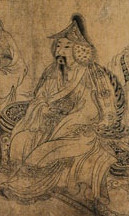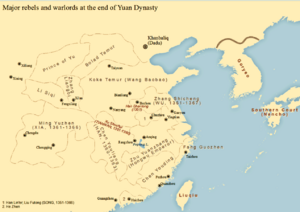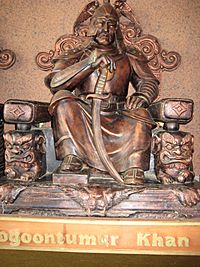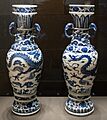Toghon Temür facts for kids
Quick facts for kids Emperor Shun of Yuan元順帝 Ukhaghatu Khan 烏哈噶圖汗 ᠤᠬᠠᠭᠠᠲᠤ ᠬᠠᠭᠠᠨ |
|||||||||||||||||||||||||
|---|---|---|---|---|---|---|---|---|---|---|---|---|---|---|---|---|---|---|---|---|---|---|---|---|---|
| 15th Khan of the Mongol Empire (Nominal due to the division of the Mongol Empire) Emperor of China |
|||||||||||||||||||||||||
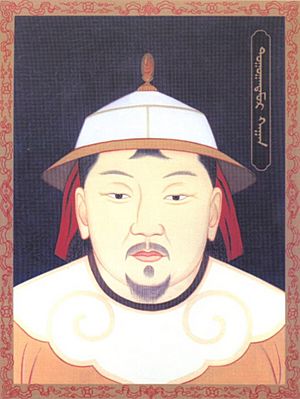
Portrait of Toghon Temür
|
|||||||||||||||||||||||||
| Emperor of the Yuan dynasty | |||||||||||||||||||||||||
| Reign | 19 July 1333 – 10 September 1368 | ||||||||||||||||||||||||
| Coronation | 19 July 1333 | ||||||||||||||||||||||||
| Predecessor | Rinchinbal Khan | ||||||||||||||||||||||||
| Successor | Himself as Emperor of the Northern Yuan | ||||||||||||||||||||||||
| Emperor of the Northern Yuan | |||||||||||||||||||||||||
| Reign | 1368 – 23 May 1370 | ||||||||||||||||||||||||
| Predecessor | Himself as Emperor of the Yuan dynasty | ||||||||||||||||||||||||
| Successor | Biligtü Khan Ayushiridara | ||||||||||||||||||||||||
| Emperor of China | |||||||||||||||||||||||||
| Reign | 1333–1368 | ||||||||||||||||||||||||
| Predecessor | Rinchinbal Khan (Yuan dynasty) | ||||||||||||||||||||||||
| Successor | Hongwu Emperor (Ming dynasty) | ||||||||||||||||||||||||
| Born | 25 May 1320, Yuan dynasty | ||||||||||||||||||||||||
| Died | 23 May 1370 (aged 49) Yingchang, Northern Yuan dynasty |
||||||||||||||||||||||||
| Empress | Empress Danashiri of Kipchak (m. 1333–executed 1335) Empress Bayan Khutugh of Khongirad clan (m. 1337–1365) Empress Ki of Haengju Gi clan (m. 1365–1370) |
||||||||||||||||||||||||
|
|||||||||||||||||||||||||
| House | Borjigin | ||||||||||||||||||||||||
| Dynasty | Yuan dynasty, Northern Yuan dynasty | ||||||||||||||||||||||||
| Father | Khutughtu Khan Kusala | ||||||||||||||||||||||||
| Mother | Mailaiti of the Karluks | ||||||||||||||||||||||||
| Religion | Tibetan Buddhism | ||||||||||||||||||||||||
Toghon Temür (born May 25, 1320 – died May 23, 1370) was a very important ruler in history. He was the last emperor of the Yuan dynasty in China. After his rule, he became the first emperor of the Northern Yuan dynasty. He was also seen as the last Khagan (a type of ruler) of the huge Mongol Empire.
During his later years, a big rebellion called the Red Turban Rebellion started. This rebellion led to the end of the Yuan dynasty and the start of the Ming dynasty. Even though the Yuan dynasty lost control of most of China, Toghon Temür's court still ruled northern China and the Mongolian Plateau. This later part of his rule is known as the Northern Yuan.
Toghon Temür was a follower of Buddhism. He studied with important Buddhist teachers.
Contents
Becoming Emperor
Toghon Temür was born when his father, Kuśala (also known as Emperor Mingzong), was living away from the main court in Central Asia. His mother was Mailaiti, who came from the Karluks people.
After a civil war in 1328, Toghon Temür's father died. His younger uncle, Jayaatu Khan Tugh Temür (Emperor Wenzong), became emperor. Toghon Temür was kept away from the court and sent to live in Goryeo (which is modern-day Korea) and later to Guangxi in South China.
When Emperor Wenzong died in 1332, his wife, Empress Dowager Budashiri, wanted Toghon Temür to become emperor. However, a powerful official named El Temür tried to put another prince on the throne. Instead, Toghon Temür's younger half-brother, Rinchinbal, became emperor. But Rinchinbal died after only two months.
El Temür still wanted to choose the next emperor. Empress Budashiri insisted that Toghon Temür should return. El Temür was worried because Toghon Temür was old enough to rule on his own and might challenge him. So, Toghon Temür's crowning was delayed for six months until El Temür died in 1333.
In 1333, Toghon Temür met Lady Gi, a woman from Goryeo. He fell deeply in love with her. Lady Ki had been sent to China to serve in the palace.
His Time as Emperor
Early Years of Rule
After becoming emperor, Toghon Temür was still influenced by powerful officials. One of them, Bayan, became very strong, similar to El Temür. Bayan made many changes and even stopped the important imperial examination system, which was how officials were chosen.
Toghon Temür wanted to make Lady Ki a secondary wife, which was unusual because secondary wives were usually from Mongol families. This caused a lot of disagreement at court, so he had to wait. In 1339, Lady Ki had a son, and Toghon Temür decided this son would be his future heir. In 1340, he was finally able to make Lady Ki his secondary wife.
As Toghon Temür grew older, he did not like Bayan's strong control. In 1340, he worked with Bayan's nephew, Toqto'a, who also disagreed with Bayan. Together, they removed Bayan from power. Toghon Temür also removed other officials who had too much control. With Toqto'a's help, he was able to take more control of his government.
Middle Years of Rule
After Bayan was removed, Toqto'a took charge of the court. His leadership brought new energy. He quickly showed that his rule would be different from Bayan's. A new Chinese era name, Zhizheng, was announced to mark this change.
Toqto'a brought back many important Chinese scholars who had left the capital. He also brought back the imperial examination system. One of his successful projects was finishing the official histories of the Liao, Jin, and Song dynasties, which were completed in 1345.
Toqto'a left his position in 1344. Several different officials then led the government between 1344 and 1349. In 1347, the emperor sent Toqto'a away to Gansu.
In 1349, Toghon Temür called Toqto'a back, and Toqto'a began his second time leading the government.
Later Years of Rule
From the late 1340s, people in the countryside faced many problems like droughts, floods, and hunger. The government did not have good plans to help, so people lost trust in it. Rebellions started across the empire. The most important one was the Red Turban Rebellion, which began in 1351 and grew very large.
In 1354, Toqto'a led a big army to stop the Red Turban rebels. But Toghon Temür suddenly removed him from power because he feared Toqto'a might betray him. This made the central government much weaker. The emperor had to rely on local leaders for help.
Toghon Temür slowly became less interested in politics. His son, Biligtü Khan Ayushiridara, who became the Crown Prince in 1353, tried to gain more power. This led to conflicts with the emperor's close advisors. Lady Ki also became very powerful during this time.
In 1364, a local leader named Bolad Temür took over Khanbaliq (the capital city) and forced the Crown Prince to leave. The Crown Prince, with help from another leader named Köke Temür, defeated Bolad Temür the next year. These internal fights made the government even weaker. In 1365, Toghon Temür finally made Lady Ki his First Empress.
Connections with Other Countries
The Pope

Between 1317 and 1343, Pope John XXII and Pope Benedict XII helped set up Catholic churches across the Mongol Empire, from Crimea to China. In 1336, people from the Alans group wrote to Pope Benedict XII, asking for a new church leader in Khanbaliq. In 1338, the Pope sent an ambassador named Giovanni de' Marignolli, who stayed in Beijing for several years. They brought gifts for Toghon Temür, including beautiful European horses.
Japan
When people from Korea captured a Japanese fishing ship, thinking it was spying, the Korean court sent the ship to Toghon Temür. He then sent the fishermen back to Japan. In return, the Ashikaga shogunate (Japan's military government) sent a monk to thank him.
Moving North
After a leader named Zhu Yuanzhang started the Ming dynasty and took control of Southern China, he sent his armies to North China. In 1368, the Ming army defeated the Yuan army. Toghon Temür left Khanbaliq (Beijing) and went to his summer home, Shangdu.
In 1369, Shangdu was also captured by the Ming. Toghon Temür then moved further north to Yingchang, in what is now Inner Mongolia. He died there in 1370. His son, Biligtü Khan Ayushiridara, became the next ruler and moved to Karakorum that same year.
The remaining Yuan rulers in northern China and the Mongolian Plateau continued to call themselves the "Emperors of China." This period is known as the Northern Yuan dynasty. Toghon Temür ruled longer than any other Yuan emperor except for Kublai Khan.
At the time of his death, the Northern Yuan still had influence from the Sea of Japan to the Altai Mountains. There were also groups in Yunnan and Guizhou who supported the Yuan and fought against the Ming. The Ming dynasty believed that the Yuan had lost the "Mandate of Heaven" (the right to rule) when they left Khanbaliq in 1368.
The Ming dynasty gave Toghon Temür the name Emperor Shun, which meant he had given up his empire peacefully. But the Northern Yuan dynasty gave him their own names, Emperor Xuanren Puxiao and Huizong.
Even after Toghon Temür's death, some Yuan supporters continued to fight the Ming in southwestern China.
His Legacy
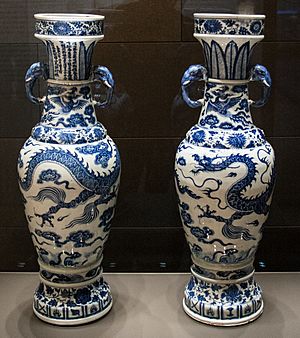
Mongolian historical writings, like the Erdeniin Tobchi, include a poem called the Lament of Toghon Temür. This poem describes his sadness after losing Khanbaliq (Beijing).
Family
Toghon Temür had several wives and children.
- First Empress: Empress Danashiri (1320 – 1335)
- Prince Maha (1334)
- Second Empress: Empress Bayan Khutugh (1324 – 1365)
- Prince Zhenjin
- Prince Xueshan
- Third Empress: Empress Gi (1315 – 1369)
- Emperor Zhaozong of Northern Yuan (1340 – 1378)
- Other Wives: He also had other wives and companions, including Lady Ruijjao, Lady Yining, and Lady Xiaoge.
- Emperor Tianyuan of Northern Yuan (born 1342)
See also
 In Spanish: Toghon Temür para niños
In Spanish: Toghon Temür para niños
- List of Yuan emperors
- List of Mongol rulers
- List of Chinese monarchs
- List of Northern Yuan khans
Images for kids
|
Toghon Temür
House of Borjigin
Born: 25 May 1320 Died: 23 May 1370 |
||
| Regnal titles | ||
|---|---|---|
| Preceded by Rinchinbal Khan |
Great Khan of the Mongol Empire (Nominal due to the division of the Mongol Empire) 1333–1368 |
Due to the collapse of Yuan dynasty in 1368, Mongol Empire also fell at the same time. |
| Emperor of the Yuan dynasty 1333–1368 |
Succeeded by Himself as Emperor of the Northern Yuan |
|
| Emperor of China 1333–1368 |
Succeeded by Ming dynasty: Hongwu Emperor |
|
| Preceded by Himself as Emperor of the Yuan dynasty |
Emperor of the Northern Yuan 1368–1370 |
Succeeded by Biligtü Khan Ayushiridara |


